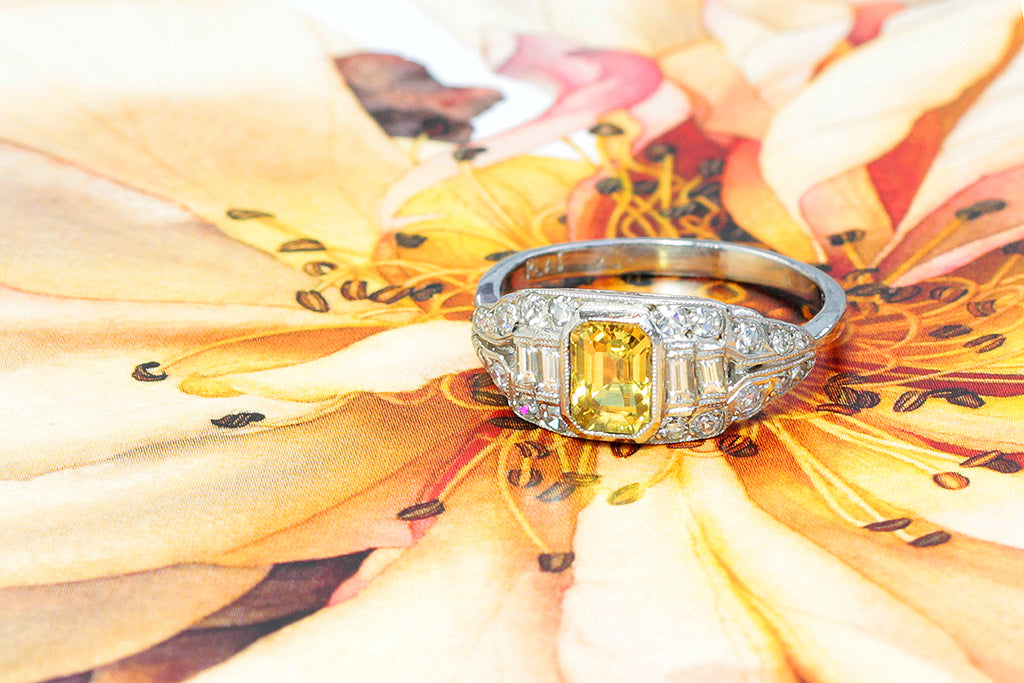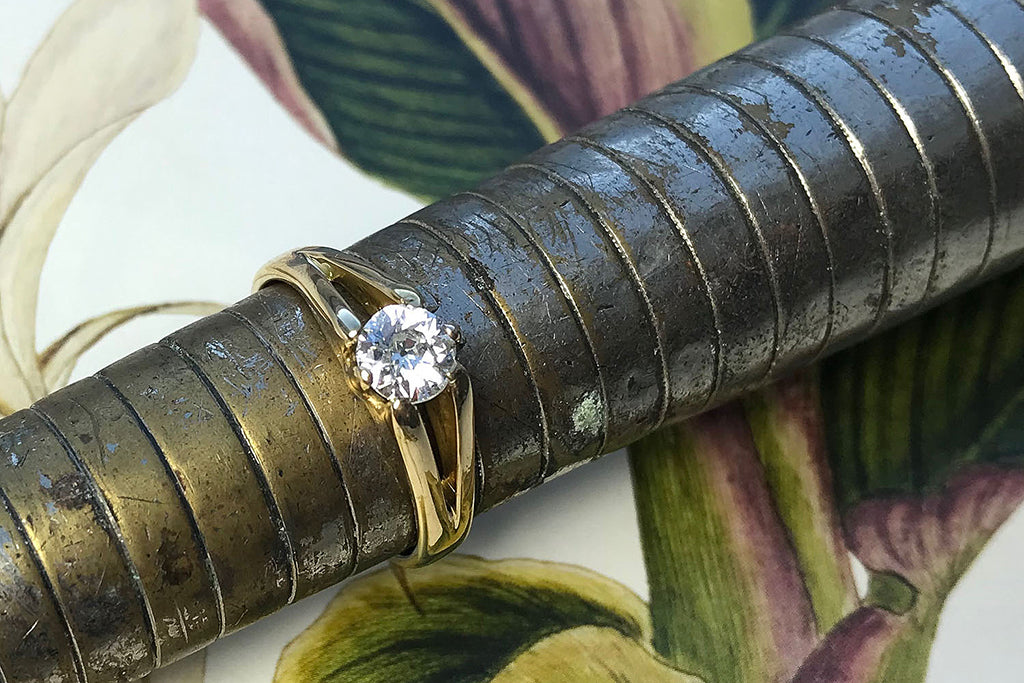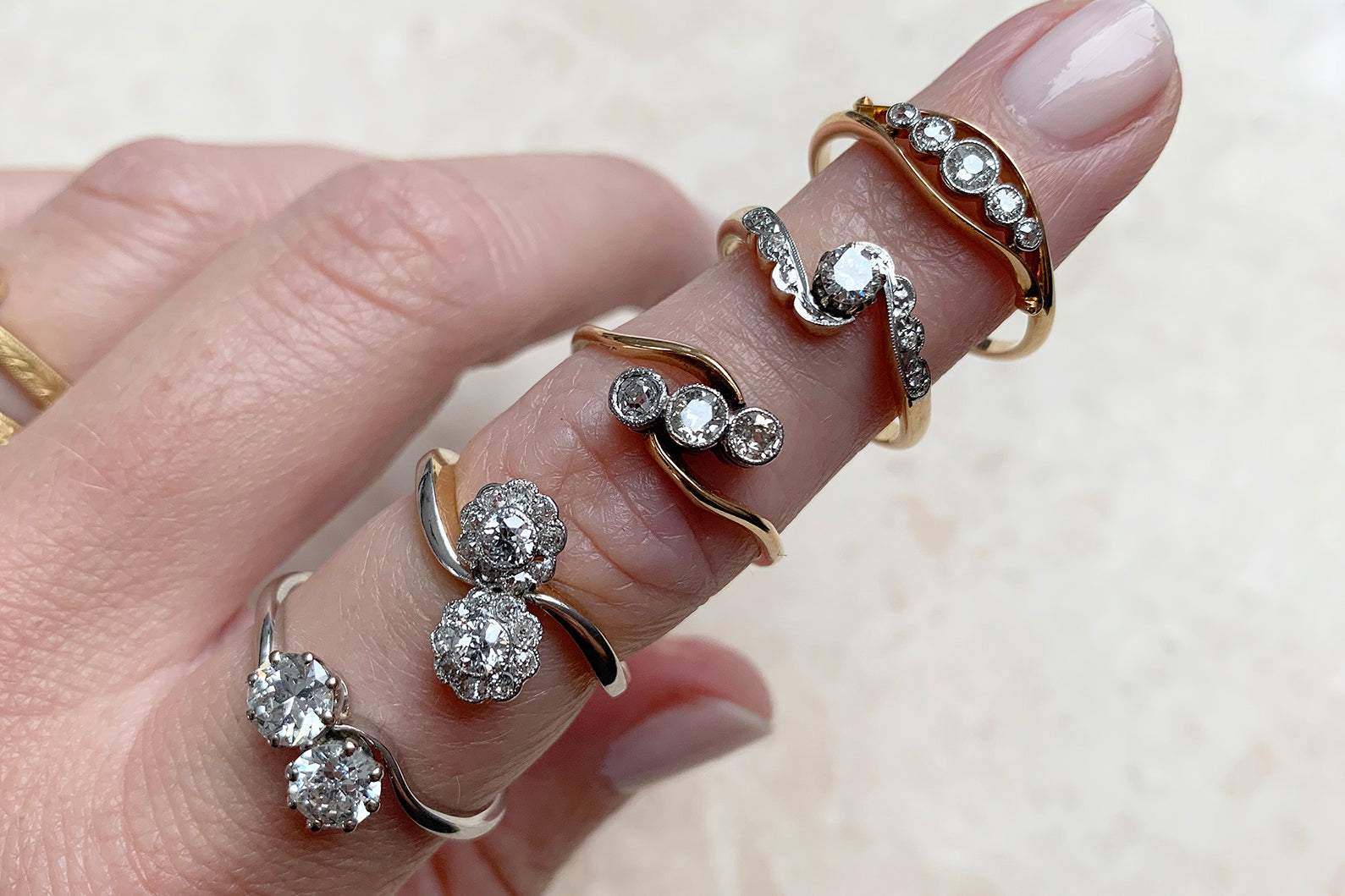
Art Deco engagement rings: A sign of the times
Art Deco was a popular design movement that shaped the 1920s and 1930s, emerging in Paris before quickly gaining global traction. Its style manifested across the spectrum of visual arts; from architecture to sculpture, painting, graphic arts and fashion, and is easily identified by abstract concepts, angular shapes, symmetry and sleek planarity.
A century on, the Art Deco period remains one of the most influential in the history of jewellery design, its legacy an indelible mark on the imaginations of jewellery lovers worldwide. Today, with authentic Art Deco and Art Deco-inspired engagement rings a firm favourite among our clients, we explore the cultural context that gave rise to the Art Deco movement and how those sentiments are echoed as distinctive features of Art Deco jewellery.
THE ART DECO MOVEMENT: A HISTORY

In the wake of the Industrial Revolution, the 1920s saw the advent of large-scale manufacturing, with machine-age technology replacing traditional craft methods. This mass production compelled artists and designers to begin enhancing the appearance of functional, day-to-day objects with aesthetically-pleasing touches. Suddenly, everything from clocks to ashtrays, cars and buildings were open to embellishment. Although many design movements are steered by political or philosophical roots and intentions, Art Deco was almost purely decorative.
The Art Deco ethos diverged from those of the Art Nouveau and Arts and Crafts movements that preceded it, which often emphasised the uniqueness and originality of handmade objects with organic, sensual, stylised forms. That crafted quality was symbolic of an elitism that opposed Art Deco's egalitarian aim to create aesthetically appealing, machine-made objects that were available to everyone; visually pleasing but not intellectually threatening.
Incredibly opulent in style, the playful exaggeration attributed to Art Deco design is also considered a reaction to the forced austerity brought about by WWI. Women newly liberated from the bleakness of war and the Edwardian ideas of ‘acceptability’ that lead up to it, the fashion of the Art Deco era was a radical contrast. Garment designs began to free the female figure, rejecting frills and allowing for more comfort; simplified silhouettes inviting Art Deco jewellery designers to go to town and adorn any possible bare surface. Plunging necklines offered new scope for dangling necklaces, a lack of sleeves made way for jewels draped over shoulders or wrapped around arms, and the demise of gloves – the staple of Edwardian fashion – freed up hands for rings of all shapes and sizes.
When the jewel-laden tomb of Tutankhamun was discovered in 1922, photographs and reports circulated and the world went Egypt-crazy. Soon, eagle and lion iconography became common themes of Art Deco jewellery alongside vivid coloured gemstones like rubies, sapphires and emeralds. Meanwhile, as Western interest in the ‘exoticism’ of China exploded, Art Deco jewellery designers also turned to oriental motifs and the use of materials such as jade, onyx and amber, where previously only diamonds would do.
As the 1930s coincided with a growing economic depression and the looming potential of WWII, an intense desire for escapism prevailed; perfect conditions for whimsical Art Deco design to continue thriving.
ART DECO ENGAGEMENT RINGS: GEOMETRIC GEMSTONE CUTS

Our Coco Art Deco-style engagement ring with a 1.24ct emerald-cut yellow central sapphire
Without a doubt, the most prominent feature of Art Deco jewellery is geometric shapes. Following the emergence of Tiffany & Co.’s revolutionary Tiffany® Setting in 1886, a single round brilliant cut diamond long reigned supreme as the quintessential engagement ring. Thanks to the development of machine-facilitated diamond cutting techniques in the early 20th century, however, there were suddenly few limitations to the shapes and faceting styles of gemstones. The general Art Deco idea was to offer a bolder and more streamlined take on jewellery, often optimising the relationship between gemstone weight and affordability in the process. With their symmetrical outlines and clean, industrial aesthetic, the distinct geometric quality of the emerald cut, baguette cut, square cut and triangle-shaped step cut are hugely emblematic of the entire Art Deco era.
ART DECO ENGAGEMENT RINGS: COLOURS GALORE
 Our Estelle diamond and emerald Art Deco target ring
Our Estelle diamond and emerald Art Deco target ring
Another signature feature to reflect the exuberant zeitgeist of the Art Deco movement is vivid colours, often combined in contrast. Whilst some Art Deco engagement rings are proudly set with single sapphires, emeralds or rubies, many also incorporate angular halos of pave-set diamonds or other small gemstones for maximum impact. A further evolution of the halo ring is the iconic Art Deco target ring, which unites a variety of coloured gemstones in concentric circles that symbolise the bull’s eye shot by Cupid’s arrow.
ART DECO ENGAGEMENT RINGS: ORNATE DETAILING
 Our Etta emerald and diamond Art Deco engagement ring
Our Etta emerald and diamond Art Deco engagement ring
With a desire for opulence at the very core of Art Deco design, elaborate details are a typical feature of engagement rings from this era. Perhaps most common is filigree work; lace-like openwork composed of intertwined wire threads of precious metal. Meanwhile, milgrain – French for ‘a thousand grains’ - is a common decorative accent, wherein minute beads of metal are applied as subtle borders on bands and gemstone settings.
ART DECO ENGAGEMENT RINGS: COMBINED PRECIOUS METALS
 Our Hattie white and yellow gold Art Deco ring
Our Hattie white and yellow gold Art Deco ring
Thanks to its strength, resistance and malleability, platinum was a firm favourite amongst Art Deco jewellery designers, allowing them to craft these intricate embellishments and outlines without compromising the integrity of the jewel. In the spirit of the Art Deco movement, however, why stop at one hue? For the sake of grandeur and impact, platinum was often combined with yellow gold.
The suffragettes and flappers didn’t want to wear cameos and tiaras; these were staples of bygone ages and underlying moods that no longer struck a chord. Instead, women of the Art Deco period coveted jewellery that was as daring and fresh as their short hair and even shorter skirts. When all’s said and done, Art Deco jewellery is about celebrating a new chapter and a novel sense of self; a spirit that will never go out of fashion.


